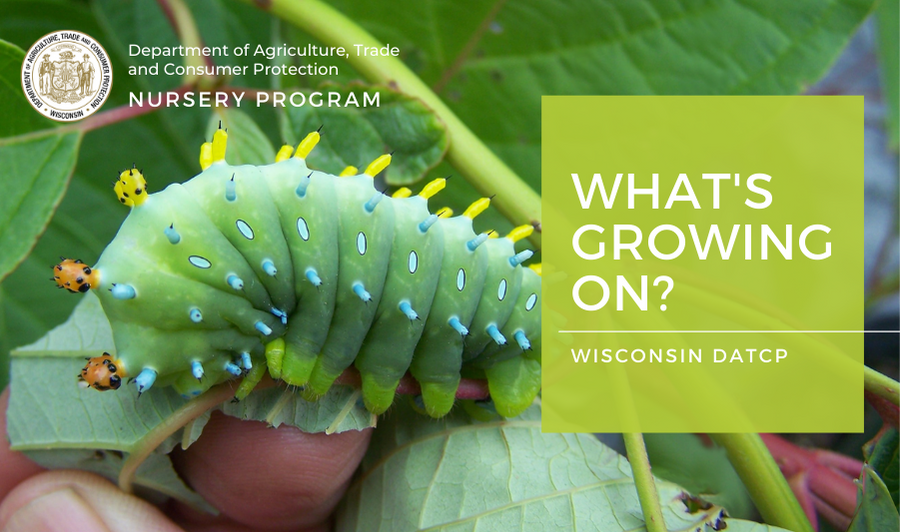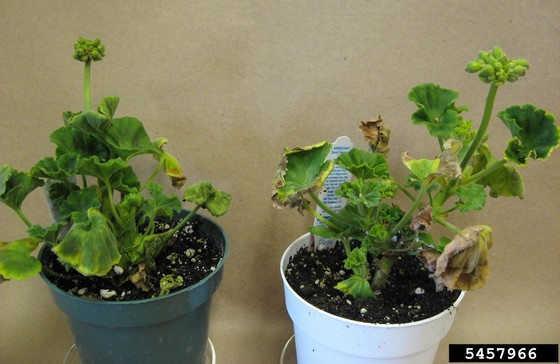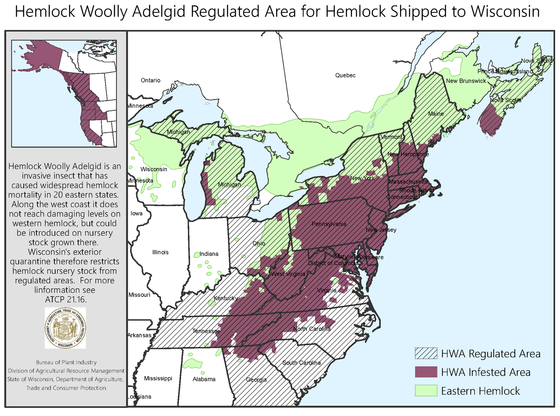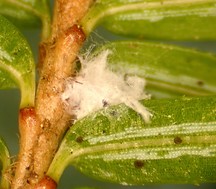|
 _____________________________________
Dear Wisconsin nurseries, Christmas tree growers, and gardeners:
Spring is just around the corner; for DATCP nursery inspectors that means we're finishing up our spongy moth egg mass inspections and gearing up for seed labeler license sampling.
Take a moment to read through a few updates from the DATCP nursery and Christmas tree programs. Please send any feedback, questions, or ideas for future e-news updates to datcpnursery@wisconsin.gov.
Having trouble viewing this email? View it as a Web page.
_____________________________________
|
|
|
When scouting your greenhouse geraniums, be on the watch for symptoms of southern wilt. The bacterial pathogen Ralstonia solanacearum race 3 biovar 2 can infect many different plant species, causing southern wilt on geraniums and brown rot on potatoes. R. solanacearum R3Bv2 is designated by the USDA as a select agent, meaning it has the potential to pose a severe threat to plant health in the United States. It is not known to occur in the United States or Canada but is occasionally intercepted in the nursery trade.
Symptoms of southern wilt on geranium begin as yellowing and wilting of lower leaves and an upward curling of leaf margins. Wilting leaves often show wedge-shaped areas of yellowing that eventually turn necrotic and brown. In severe cases the plant may suffer stem collapse, desiccation, and death.
Symptoms of R. solanacearum R3Bv2 on geranium | Jean L. Williams-Woodward, University of Georgia, Bugwood.org
Symptoms of southern wilt can be confused with those of bacterial blight, a disease caused by a different bacterium, Xanthomonas campestris pv. pelargonii. Similar to southern wilt, the lower leaves of geraniums with bacterial blight may turn yellow, wilt, and die. These symptoms can move up the plant, and potentially cause death of the whole plant.
 Bacterial blight of geranium (Xanthomonas hortorum pv. pelargonii) | Sandra Jensen, Cornell University, Bugwood.org
Early detection is key to protecting Wisconsin’s agriculture. If you suspect geraniums at your nursery may be infected with R. solanacearum R3Bv2 contact DATCP’s nursery program at DATCPnursery@wisconsin.gov or (608) 516-7617.
_____________________________________
|
|

Over the winter months, we are diving into the different compliance agreements you may need depending on your nursery operation. A compliance agreement is a written agreement between a person engaged in growing, handling, or moving regulated articles (plants and plant parts) and a governmental agency to facilitate the movement of such articles. Compliance agreements outline what requirements must be met dependent on the origin of the articles and the destination. Federally regulated plant pests and diseases require a compliance agreement with USDA-APHIS, all other agreements are with WDATCP. Compliance agreements are valid for one year and must be renewed annually, as needed. There is no fee to enter into a compliance agreement.
Review Japanese Beetle compliance agreements in the December WGO.
Review Spongy Moth compliance agreements in the January WGO.
Review Black Stem Rust/Barberry Compliance Agreements in the February WGO.
Hemlock Woolly Adelgid Compliance Agreements

Hemlock woolly adelgid (HWA) is a tiny fluid-feeding insect that kills eastern hemlock trees (Tsuga canadensis). It has not been found in Wisconsin to date. DATCP has an "exterior quarantine" in place to restrict imports of items that could introduce hemlock woolly adelgid to our state.
Items regulated by the HWA exterior quarantine include: hemlock seedlings, hemlock nursery stock, hemlock logs or lumber with bark; hemlock chips with bark and hemlock bark.
Infested areas include nearby states like Michigan and Ohio as well as the following states and Canadian provinces: Alaska, California, Connecticut, Delaware, Georgia, Kentucky, Maine, Maryland, Massachusetts, New Jersey, New York, North Carolina, Oregon, Pennsylvania, Rhode Island, South Carolina, Tennessee, Vermont, Virginia, Washington, West Virginia, and the provinces of British Columbia, Ontario and Nova Scotia, Canada.
Nursery dealers and growers importing hemlock (Tsuga spp. including cultivars of T. canadensis, T. caroliniana, T. chinensis, T. diversifolia, T. heterophylla, or T. mertensiana) from any state in the infested area should contact DATCP to sign a compliance agreement. Nursery dealers and growers will also need to supply documentation showing the stock is clean and free of HWA. If no compliance agreement has been set up, each shipment from an infested area must be accompanied by a state phytosanitary certificate verifying the hemlock material was inspected by a pest control official in the state of origin and found to be free from hemlock woolly adelgid or effectively treated to destroy the pest.
Contact Jennifer Oestreich at Jennifer.Oestreich@Wisconsin.gov or (715) 701-1375 with questions, or to sign up for a Hemlock Woolly Adelgid Compliance Agreement.
|
_____________________________________
|
|

The Wisconsin DNR Forest Health Program posts newsletter articles about insects, diseases, invasive plants and other issues that affect our forests throughout the year. Articles include information on seasonal field observations, management recommendations, and upcoming webinar and workshop presentations.
Check out the March issue to find the Wisconsin DNR 2022 Forest Health Annual Report and much more. Subscription information found here.
_____________________________________
|
|

To prevent the introduction of insect pests and plant diseases, Michigan has several plant pest quarantines in place. Two of the most misunderstood are the Balsam Woolly Adelgid quarantine and the Hemlock Woolly Adelgid exterior quarantine. Nurseries in Wisconsin should be aware of these quarantines to help reduce the risks associated with these invasive, conifer-killing insects, and to avoid enforcement action. Both of these invasive insects are found in Michigan, but neither have been found to be established in Wisconsin. (left image is gouting of Fraser fir from balsam wooly adelgid, USDA Forest Service - Region 8 - Southern, USDA Forest Service, Bugwood.org)
Balsam Woolly Adelgid Quarantine
Regulated articles: All true fir species (Abies spp.)
Regulated areas: All out-of-state sources must meet the requirements below. Areas known to be infested must meet additional requirements (CA, ID, ME, NH, NY, NC, OR, TN, VT, VA, WA, WV & Canadian provinces BC, NB, NL, NS & PE).
Additional declaration from a non-infested area: "The regulated articles have not been held in the proximity of regulated articles originating from areas regulated for balsam woolly adelgid."
Hemlock Woolly Adelgid Exterior Quarantine
Regulated articles: Tsuga spp. (hemlock) and Picea torano (Tiger-tail spruce)
Regulated areas: All out-of-state sources must meet the requirements below. Areas known to be infested with HWA must meet additional requirements (AK, CA, CT, DE, GA, ID, KY, ME, MD, MA, NH, NJ, NY, NC, OH, OR, PA, RI, SC, TN, VA, WA, WV & Canadian provinces BC, NS & ON).
Additional declaration from a non-infested area: “The regulated articles in this shipment have not been held or stored in the proximity of regulated articles originating from a regulated area."
Requirements for both quarantines
-Advance notification (with a copy of the certificate described below) of shipments of regulated articles from the shipper to MDARD-NurseryCE@Michigan.gov, and;
-A Plant Health Certificate issued by WI-DATCP stating the origin of the stock, number and type of regulated articles and appropriate additional declarations must accompany the shipment.
Contact Amber Neils, MDARD’s Export and Compliance Specialist at NeilsA@Michigan.gov or 517-449-0786 if you have any questions.
-Contributing author Amber Neils, MI-DARD
|
_____________________________________
|
|
|
The Wisconsin Invasive Species Council is accepting nominations for the Invader Crusaders Awards through March 27, 2023.
Invader Crusaders are Wisconsin residents and organizations who made significant contributions in 2022 to prevent, control or eradicate invasive species that harm Wisconsin's native wildlife, wetlands, forests, prairies, lakes and rivers. Nominees can be individuals, groups or organizations who showed exemplary efforts to address issues surrounding terrestrial and aquatic invasive plants and animals.
To nominate an individual or organization, download and complete a nomination form on the Wisconsin Invasive Species Council webpage and email the completed form to invasive.species@wisconsin.gov by March 27. Award recipients will be recognized in June during Invasive Species Action Month.
-Excerpts from 02-10-2023 News Release
_____________________________________
|
|
|
|
|